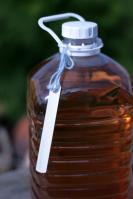Homemade Elderflower Wine
Elderflowers are in abundance this year after our warm Spring so here is how to make Elderflower Wine step by step from our master chef on the Dragon's Peninsula in North Wales.
This is a delightfully light and fragrant wine redolent of spring days and civilised living.
The elderflowers are a joy to pick: a feast for eyes & nose. There's something quite magical in turning flowers into wine.
Makes 4.5 litres or 6 standard wine bottles
Ingredients
500ml picked elderflowers, pressed or shaken down gently. Don't include green stems. Rinse if you feel it's necessary
1.5kg sugar Granulated is fine and best to use white otherwise the colour/flavour will dominate
250g raisins washed and lightly chopped
1/2 mug strong tea, cooled
3 lemons squeezed for their juice
1 tsp yeast nutrient or 1/4tsp of yeast extract, marmite or malt extract
1 tsp yeast (preferably a wine yeast)
4.5l boiling water
Note on the ingredients
The flowers provide the flavour.
The sugar is converted by the yeast into alcohol and carbon dioxide. You could use honey, or white grape juice (pure or concentrated) or a mixture of these to replace the sugar.
The raisins provide body and a smooth finish to the wine.
The tea also helps body and flavour by providing tannin.
The yeast nutrient or yeast extract provides easy food for the yeast to get off to a good start.
An optional ingredient is Pectolase. This is an enzyme derived from a fungus which breaks down pectin which can produce a 'haze' in the wine. If you want to use this, follow the supplier's instructions.
You'll also need something to thoroughly sterilise all your tools and equipment You can use sulphite or campden tablets. There are a number of commercial cleaning/sterillising powders available from homebrew shops and chemists.
Equipment
 You'll need the following:
You'll need the following:
a brewing bucket or big bowl that will hold the liquid with room for frothing and which should be capable of being covered a big spoon or paddle for stirring
a thermometer
two 5l demi-johns or containers to store your wine while it ferments and clears. You can improvise with 5l water bottles
an airlock to seal the demijohn from contaminants and allow carbon dioxide out. You can improvise with cotton wool, clingfilm & an elastic band
a funnel comes in handy, a funnel with integral strainer is great. Use a sieve otherwise
a piece of plastic tubing to siphon the wine out of demi-johns
six bottles to hold you finished wine and corks to seal them. You can put cork covers and labels on to make the bottle look beautiful.
Method
Make sure all your equipment is clean and sterile and you have all your ingredients to hand.
Dissolve the sugar in 500ml of the boiling water. Stir until you are sure there are no granules left.
Place the flowers, raisins & lemon juice in a bucket.
Pour over the remaining 4l of boiling water, add the sugar solution and stir lightly to mix.
Monitor the temperature of the liquid. It will need to come down to about 21C before you can add the yeast. Depending on the ambient temperature this can take a while. You could start in the morning and finish in the afternoon or start later and leave overnight. Make sure the bucket or container is well covered with a lid or tea towel or similar while you are waiting.
Once the liquid is down to 21C add the tea, yeast nutrient & yeast and cover again. Put in a warm place.
The liquid should soon start to ferment visibly with bubbles of gas being produced within 24 hours.
Allow the liquid to ferment unitl the really vigorous fermentation stops. This could take from 5 - 14 days depending on conditions.
Strain the liquid into a sterilised demijohn (or other container). Top up to the shoulder of the container with cooled boiled water and seal with an air lock. You should still see bubbles coming through the air lock which shows the wine is still fermenting. Leave in a warm place.
After a while fermentation will stop and the wine will begin to clear and you will see a sediment start to appear at the bottom of your container. This could take from 2-6 weeks depending on temperature.
Once this stage has arrived, siphon the wine from one demi-john into another sterilised demi-john leaving the sediment behind. Top up to the shoulder with cooled boiled watwr. Seal with an airlock or bung. Then allow the wine to clear completely. This can take six months or more. If you notice a quantity of sediment appearing. 'rack' the wine again by siphoning it off the sediment into a sterilised demi-john.
Once the wine is clear and bright, siphon from the demi-john into clean, sterilised bottles and cork.
The wine should be stored in cool conditions and will continue to improve for up to 18 months. Yeah right!
Carl Legge lives on the Dragon's Tail, the Llyn Peninsula in Wales on a permaculture smallholding and writes a regular blog. CLICK HERE for delicious recipes and more!




